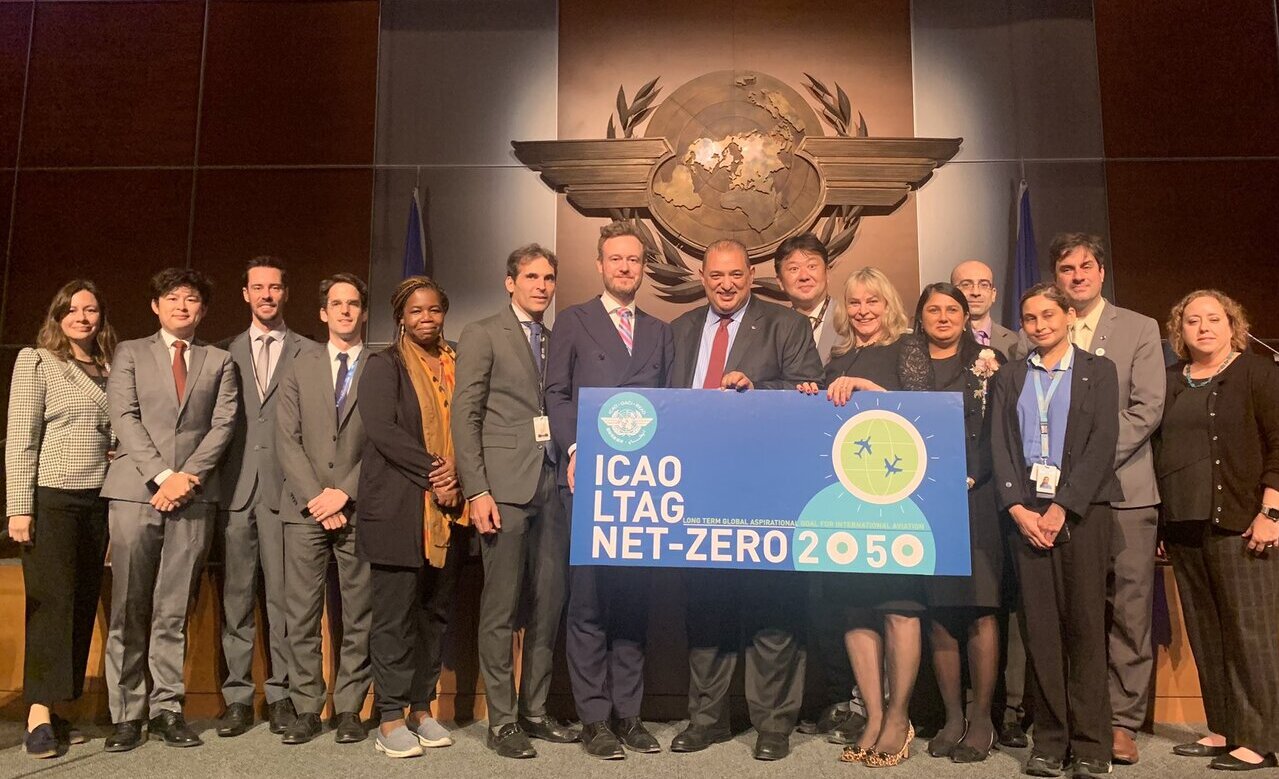Navigation menu
- Education
- Emissions & Air Quality
- Infrastructure & Services
- Meteorology & Climate
- News
- Physical Chemistry
- Projects
- The Team
Written by: Thomas Rötger
On 7 October 2022, at the end of 2 weeks of negotiations during the 41st ICAO Assembly, the 193 ICAO Member States took the historic decision to adopt a collective long-term global aspirational goal (LTAG) of net-zero carbon emissions of international aviation by 2050. This resolution was based upon a report on the feasibility of a long-term goal, which had been elaborated over more than two years by a group of over 280 experts from the 37 States and 15 international organisations that are Members and Observers of ICAO’s Committee on Aviation Environmental Protection (CAEP).
The LTAG report was approved by CAEP in February 2022 (see METENVIA-blog post dated 28.02.2022). In July 2022, a high-level meeting, gathering high-level officials from States and international organisations, was held to prepare the decision of the ICAO Assembly, where the net-zero goal obtained support by the vast majority of the Member States. At the Assembly, the resolution on the net-zero emissions goal was adopted unanimously, with a remarkably low number of only four States filing reservations on specific clauses in the Resolution.
To achieve the LTAG, a combination of different measures is planned to be implemented, including three main pillars, namely:
- New aircraft technologies, such as hydrogen and electric propulsion, blended-wing bodies and similar unconventional aircraft configurations, as well as improvements in aerodynamics, engine efficiency and lightweight materials;
- Operational improvements through upgrades of airport and airspace infrastructure, more efficient flight procedures and air traffic management measures such as free routing;
- Sustainable fuels and energies, i.e., biogenic and synthetic fuels (e.g., power-to-liquid and solar fuels) as well as unconventional renewable propulsion energies including battery electricity and hydrogen for both fuel cells and gas turbines
An expectedly small remaining amount of carbon emissions that cannot be avoided by these technical means will have to be compensated by market-based measures, namely carbon offsets supporting emissions reductions outside the aviation sector, and in the future increasingly carbon removal measures.
Within the technology area, Thomas Rötger from ZHAW’s Center for Aviation had been leading, together with Richard Wahls from NASA, a sub-group investigating the emissions reduction potential of advanced aircraft concepts and energy storage, including electric and hydrogen aircraft, blended wing bodies and similar radically new concepts.
Already last year, the aviation industry had committed to a net-zero carbon emissions goal, replacing the industry’s well-known former goal, adopted in 2009, of reducing the global aviation emissions in 2005 by 50% until 2050, which had led to an impressive number of new developments and innovations in sustainable aviation technology. The net-zero goal now being supported by the governments of the world is hoped to be inspirational for new research and development and the implementation of innovative clean technologies.
While the Assembly Resolution does not prescribe a “trajectory” to be followed towards the net-zero goal between now and 2050, it requests to continuously monitor the emissions reductions of global aviation. It is expected that details of how to do this will be discussed at the next CAEP Steering Group meeting in December in São Paulo.
It should be noted that the LTAG is a CO2 emissions reduction goal and does not include non-CO2 emissions of aircraft, which contribute to climate change as well – a widely noted article by Lee et al.[1] estimates that today, roughly one half of aviation’s climate impact comes from contrails and contrail-induced cirrus clouds, one third from CO2 emissions and the remaining one sixth from nitrogen oxides. However, contrary to CO2 emissions, which are directly proportional to fuel burn, non-CO2 emissions depend on a lot of factors that are difficult to predict and/or strongly variable, such as air humidity. Operational methods to reduce non-CO2 emissions are under development, but still in an experimental stage and likely to be implementable by the end of this decade.
Another important environmental outcome of the 41st ICAO Assembly was the completion of the first periodic review of the Carbon Offsetting and Reduction Scheme for International Aviation (CORSIA). The basic idea of CORSIA is that all emissions above a baseline threshold must be offset through surrendering a corresponding number of carbon credits; i.e., “net” emissions of aviation (physical emissions minus offsets) would remain constant over time despite traffic growth (“carbon-neutral growth from 2020”). Initially, the baseline was defined as the average of global emissions in 2019 and 2020; after the outbreak of the COVID-19 crisis it became obvious that the 2020 emissions are inappropriate to determine a meaningful baseline. As a preliminary measure, the 2019 emissions only were used as the baseline for the first years of CORSIA operation. The 41st Assembly now defined the CORSIA baseline from 2024 onwards as 85% of the CO2 emissions in 2019, to reflect the slower growth of air traffic after the COVID-19 crisis and the increased necessity to reduce emissions, while avoiding the unrealistically low 2019/2020 average as a reference.
[1] D. Lee et al., The contribution of global aviation to anthropogenic climate forcing for 2000 to 2018, Atmospheric Environment, Volume 244, 1 January 2021, 117834.
